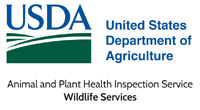United States Department of Agriculture: Animal and Plant Health Inspection Service

United States Department of Agriculture Wildlife Services: Staff Publications
Document Type
Article
Date of this Version
2019
Citation
Young, J.K., J. Draper, and S. Breck. 2019. Mind the gap: Experimental tests to improve efficacy of fladry for nonlethal management of coyotes. Wildlife Society Bulletin 43(2):265-271. doi: 10.1002/wsb.970
Abstract
Coyotes (Canis latrans) are the top predator of livestock in the contiguous United States. Developing more effective nonlethal tools to prevent coyote depredation will facilitate coexistence between livestock producers and coyotes. Fladry is a nonlethal deterrent designed to defend livestock by creating a visual barrier to wolves (C. lupus). Fladry may also be effective with coyotes, but large gap spacing between flags may reduce its efficacy. To address this issue, we performed 2 experiments on captive coyotes using fladry modified to reduce gap spacing at the U.S. Department of Agriculture, Predator Research Facility in Millville, Utah, USA, during 2015–2016 and 2017–2018. In 2015–2016, we tested 2 styles for attaching flags (top‐knot and shower‐curtain) to the rope‐line that reduce gaps by preventing coiling of individual flags.In2017–2018,wetestedtheefficacyofgapspacing(27.9cmvs.45.7cm)between flags for preventing coyote crossings. For both tests, we compared the time until coyotes crossed the fladry between treatment types. We found no differences in time to crossing between the 2 attachment designs. In our second experiment, fladry with smaller gaps between flags had greater efficacy of preventing coyote crossings than did fladry with larger gaps. Our results also indicated that for each additional minute coyotes spent interacting with fladry overall (i.e., increased persistent behavior), survival of the barrier decreased. These results suggest that persistent coyotes may overcome neophobia more rapidly than coyotes that do not exhibit persistent behaviors. Furthermore, use of top‐knot fladry and coyote‐width spacing will increase protection of livestock from coyotes.
Included in
Natural Resources and Conservation Commons, Natural Resources Management and Policy Commons, Other Environmental Sciences Commons, Other Veterinary Medicine Commons, Population Biology Commons, Terrestrial and Aquatic Ecology Commons, Veterinary Infectious Diseases Commons, Veterinary Microbiology and Immunobiology Commons, Veterinary Preventive Medicine, Epidemiology, and Public Health Commons, Zoology Commons


Comments
U.S. government work